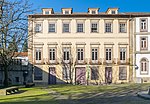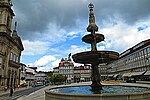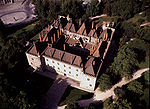Padrão do Salado
Buildings and structures in Guimarães

The Padrão Comemorativo da Batalha do Salado, commonly referred to as just Padrão do Salado, is a 14th century monument located in the freguesia of Oliveira, São Paio e São Sebastião, inside the Historic Center of Guimarães area, in Portugal. Located in front of the Church of Nossa Senhora da Oliveira, the Padrão do Salado has been classified as a National Monument since 1910.
Excerpt from the Wikipedia article Padrão do Salado (License: CC BY-SA 3.0, Authors, Images).Padrão do Salado
Largo da Oliveira, Guimarães
Geographical coordinates (GPS) Address Phone number Nearby Places Show on map
Geographical coordinates (GPS)
| Latitude | Longitude |
|---|---|
| N 41.44284 ° | E -8.29279 ° |
Address
Infusões bar
Largo da Oliveira 172 - 174
4800-000 Guimarães (Oliveira, São Paio e São Sebastião)
Portugal
Open on Google Maps











